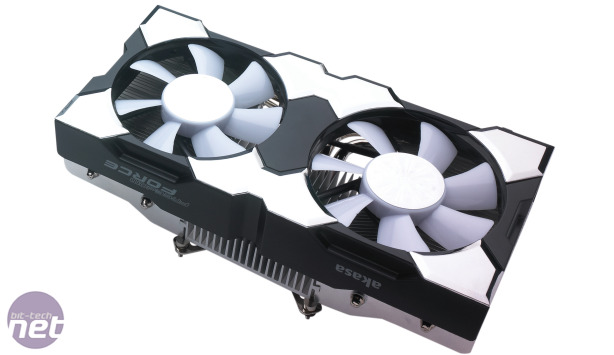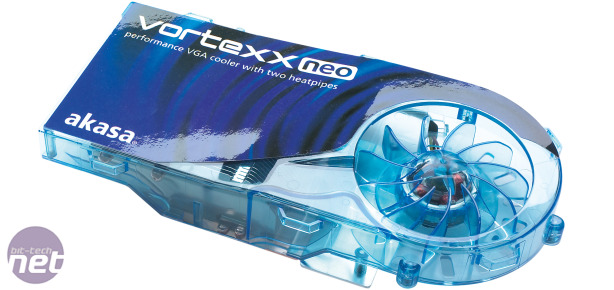Graphics Card Coolers Investigated
May 19, 2010 | 08:19
Companies: #akasa #alpenfohn #arctic-cooling #scythe #thermalright

Akasa Freedom Force
Manufacturer: AkasaUK Price (as reviewed): £34.69 (inc. VAT)
US Price (as reviewed): N/A
The Freedom Force is a chunky-looking cooler with two 80mm fans directing airflow onto the PCB. Heatsinks are included for the RAM on your graphics card but unfortunately the VRMs are left to fend for themselves apart from some airflow from one of the 80mm fans. Power is supplied using a 3-pin connector but a 3-pin to 4-pin Molex adapter is included along with some TIM.
The Freedom Force was a sync to install with just four mounting points to secure. Threaded pins pass through four of the holes in the PCB and are secured on the other side with small nuts. As you screw these on, the pins gradually move up onto the nuts, eventually pushing your screwdriver out the other end. This provides a crude but effective way of getting a flat mount onto the GPU. We found it’s still possible to mount the Freedom Force with the GTX 280’s back plate in place, providing better cooling for the RAM modules on this side of the PCB than using the included heatsinks.
The Freedom Force managed an idle delta T of 18ºC on the HD 4890, making the stock ATI cooler looking like more of a George Foreman grill with its delta T of 40ºC – a difference of 22ºC. We loaded up Furmark to turn up the heat and the difference here was much less marked; the Freedom Force was only 3ºC cooler the stock ATI HSF, topping out at a delta T of 49ºC.
Our GTX 280 proved too much for it though, with the PC crashing during our Furmark test. We suspect this is due to the Freedom Force’s small contact plate not covering the whole of the GTX 280’s huge core, and different testing conditions to when we last looked at it. In any event, the Freedom Force failed to tame the GTX 280.
The Freedom Force wasn’t particularly quiet either, but the noise was less intrusive than the stock HD 4890 cooler, especially under load. However, at £34, it costs twice the amount of the Vortexx Neo which is quieter and performs roughly same.
For Radeon HD 4890:
- Overall
- x
- x
- x
- x
- x
- x
- -
- -
- -
- -
- 6/10
- Overall
- x
- -
- -
- -
- -
- -
- -
- -
- -
- -
- 1/10
Akasa Vortexx Neo
Manufacturer: AkasaUK Price (as reviewed): £11.71 (inc. VAT)
US Price (as reviewed): N/A
The Vortexx Neo isn't a new product at all - we reviewed it in Custom PC back in 2008 when we bolted it to a GeForce 8800 GT. Due to its age it’s only compatible with one of the three graphics cards we were testing with this month, the HD 4890.
The Vortexx Neo’s 80mm fan is powered using a 3-pin connector, but Akasa includes a 3-pin to 4-pin Molex adapter in the box. We’d recommend using it to avoid any issues with automatic speed control if connected to a motherboard fan header. Installation is incredibly quick and simple thanks to just four mounting points and a large plate that cools the RAM on the PCB, eliminating the need for additional separate heatsinks.
The plate doesn’t make contact with the VRMs though, and no heatsinks are included for them either. However, the fan shroud has small notches to allow some air to be directed on to the VRMs. This certainly seemed to do the trick as the Vortexx Neo passed both our Furmark and Crysis tests without a hint of instability.
Compared to the stock ATI cooler, the Vortexx Neo managed to lower the idle delta T from 40ºC to 24ºC - a healthy 16ºC reduction. However, it was 2ºC ahead of its supposed successor, the Freedom Force in the Furmark test, with a delta T of 47ºC. This was only 5ºC better than the stock ATI cooler, but this wasn’t its biggest advantage. It was inaudible outside our Antec Nine Hundred Two case – a far cry from the screaming stock cooler of the HD 4890.
The chances are that the Vortexx Neo won’t bring your temperatures down enough to squeeze a higher overclock out of your HD 4890. However a 5ºC reduction in load temperature and 16ºC reduction in idle temperature can only be a good thing.
For Radeon HD 4890:
- Overall
- x
- x
- x
- x
- x
- x
- x
- x
- -
- -
- 8/10

MSI MPG Velox 100R Chassis Review
October 14 2021 | 15:04











Want to comment? Please log in.